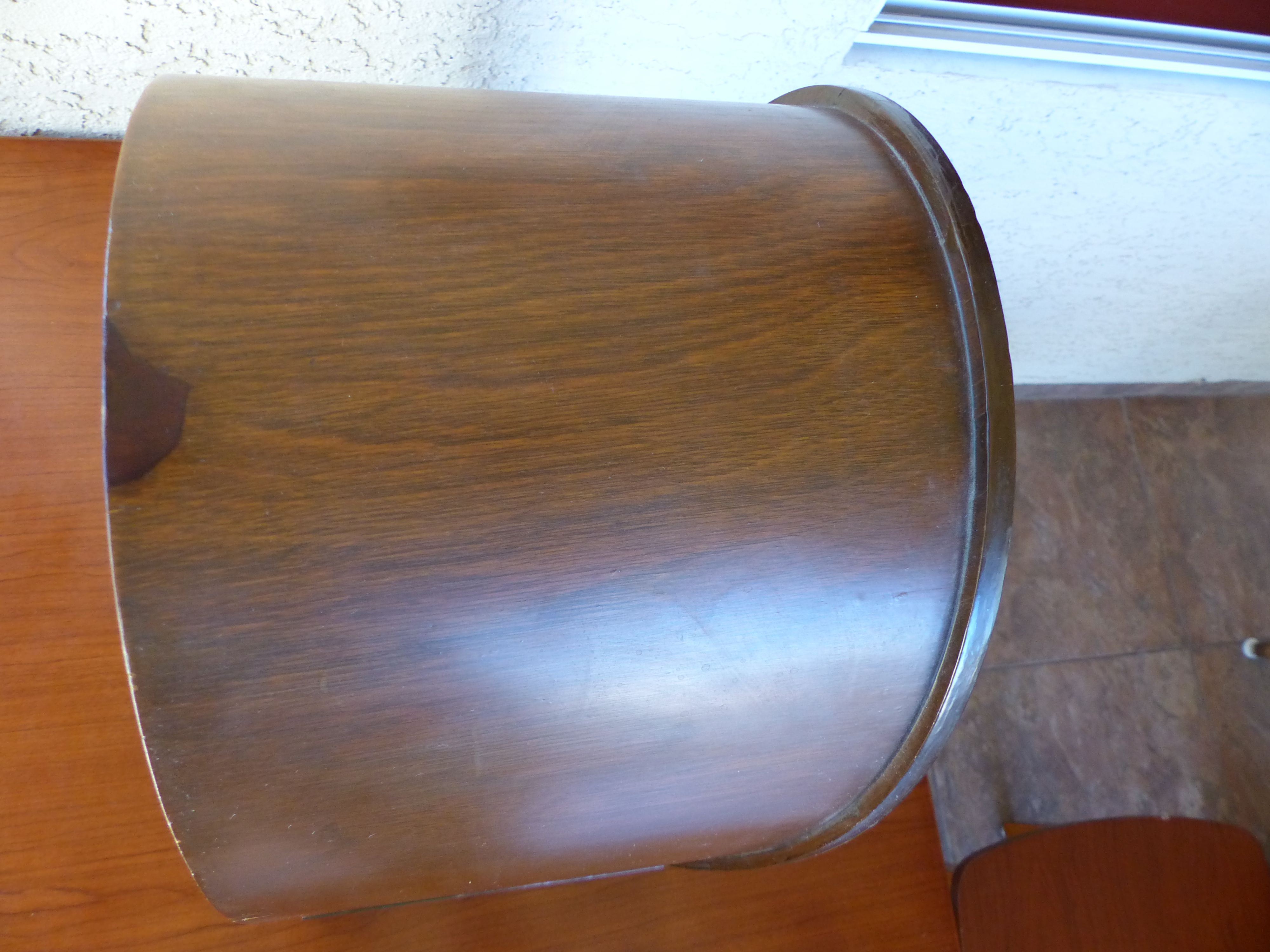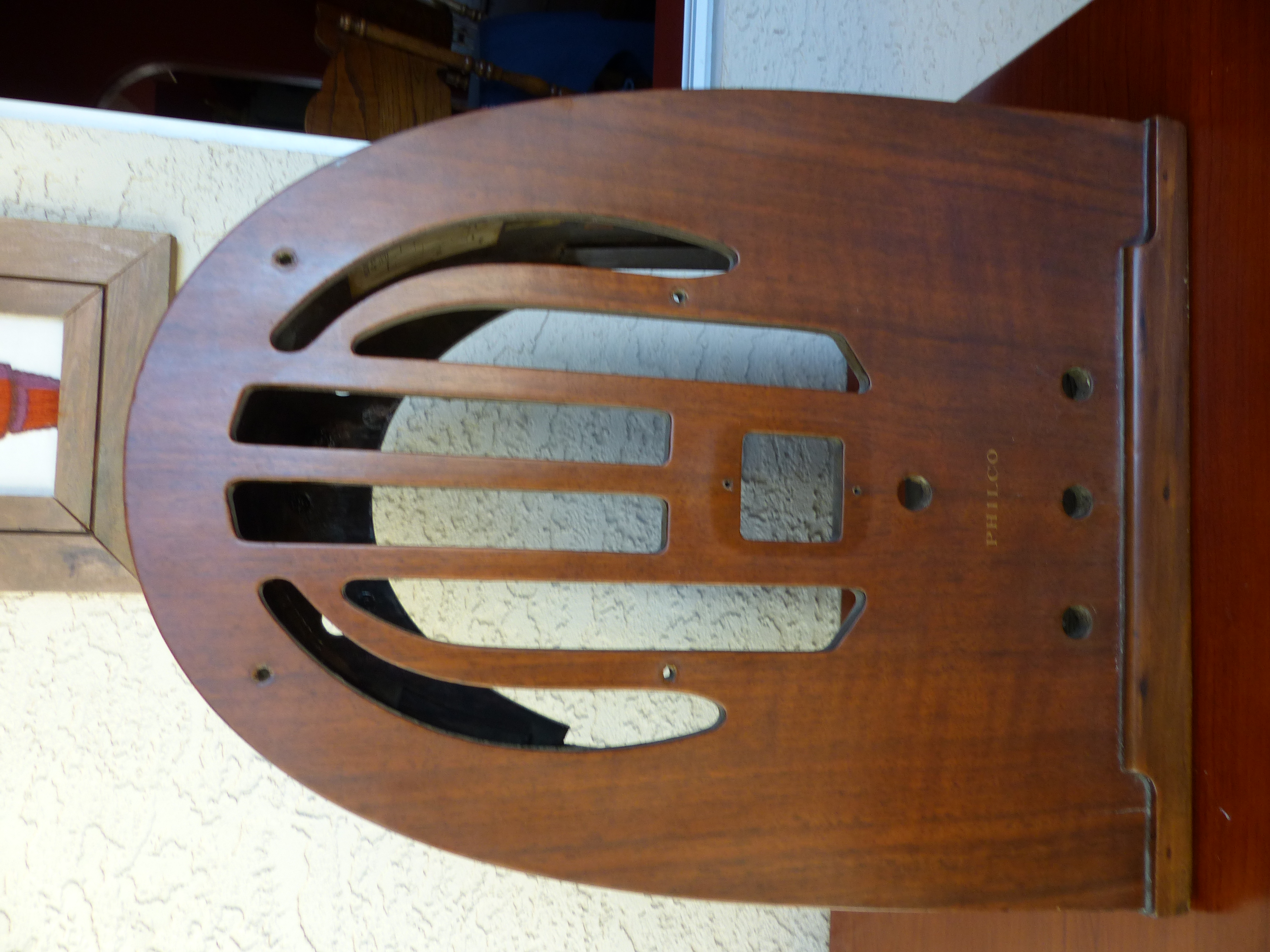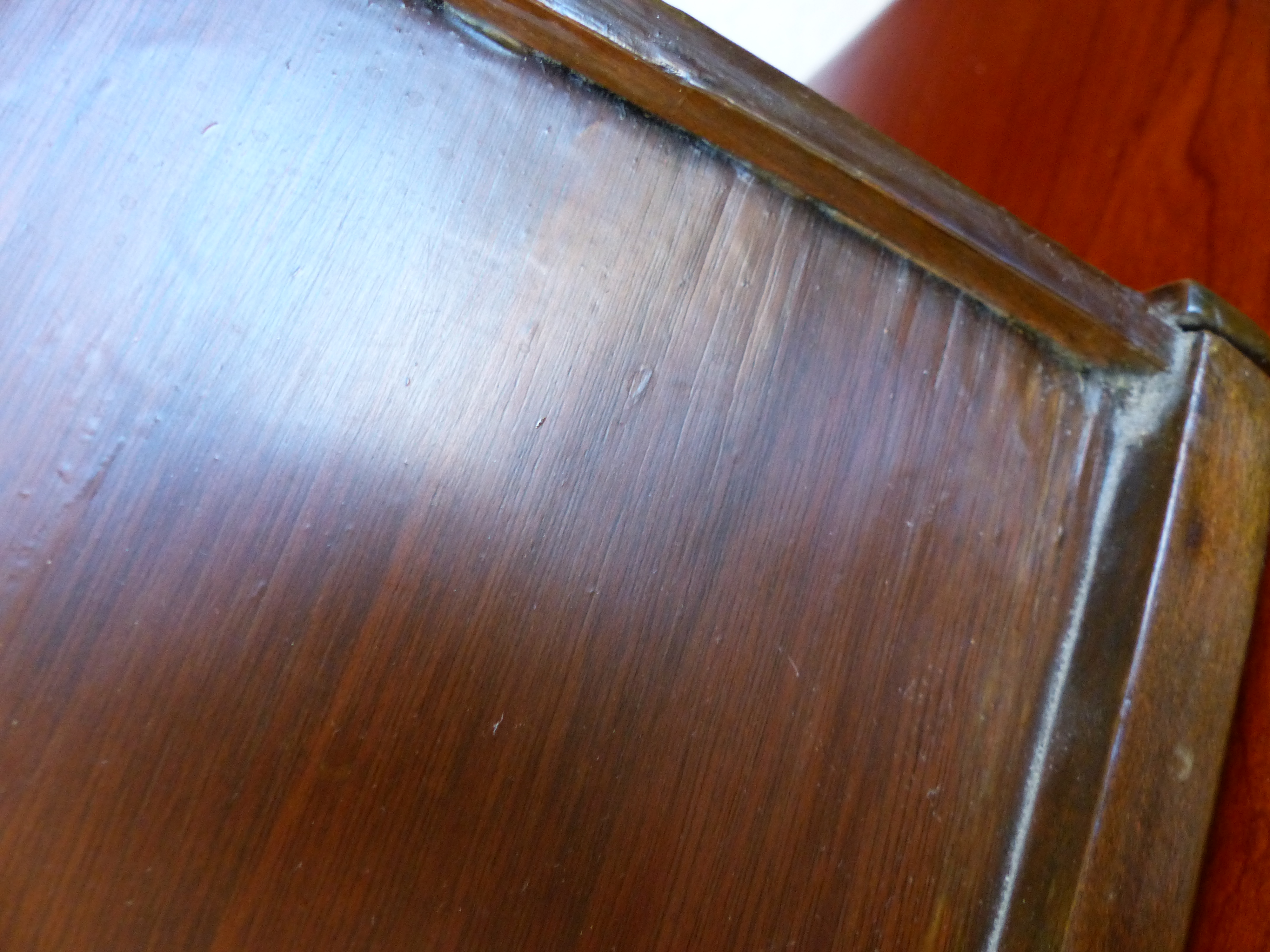Posts: 95
Threads: 34
Joined: Oct 2016
City: Fountain Hills, Arizona
Attached are photos of my late model 60 currently being restored. The front is pristine; I want to leave it as it is.
The sides have some issues and will need to be stripped and refinished. Also, one of the side pics shows a heavy application
of some overcoat that I want to remove.
Two questions; 1) what color stain would best match the front?
2) should I apply an overcoat once the sides are refinished? Should the overcoat remain Matte or Glossy?
Thanks for any advise.
Don




Posts: 4,913
Threads: 54
Joined: Sep 2008
City: Sandwick, BC, CA
I think that someone, in the past, has already stripped, and refinished that cabinet: #1 It has a satin finish. #2 That finish has debris stuck in it and possibly brush marks. #3 The cabinet is all monotone, no shading lacquer, including on the base, and around the edge of the front panel. #4 This is probably the most glaring evidence that it was stripped and refinished, the "Philco" decal on the front panel is completely the wrong font.
Regards
Arran
(This post was last modified: 02-05-2021, 06:17 PM by Arran.)
Posts: 95
Threads: 34
Joined: Oct 2016
City: Fountain Hills, Arizona
Thanks, Arran. Based on your comments, I will be stripping entirely and refinishing.
Don
Posts: 13,776
Threads: 580
Joined: Sep 2005
City: Ferdinand
State, Province, Country: Indiana
Arran is absolutely right. I hope for your sake that whoever refinished that cabinet did not use polyurethane.  
The original finish was lacquer; Philco did not use stains and varnish. The cabinet overall is Mohawk Medium Walnut. The base trim needs to be something darker. Mohawk Perfect Brown won't be dark enough; Extra Dark Walnut too dark. I will let someone else comment on a suitable color for the base trim.
The proper decal is DCL-PH8 from Radio Daze.
https://www.radiodaze.com/philco-8-decals-dcl-ph8/
The proper finish coat is clear gloss lacquer which then should be hand rubbed after the finish dries for a few weeks, to cut some of the shine down.
Obviously this should be done outdoors, in warm weather (70 to 80 degrees), LOW humidity (as low as possible), in the shade. DO NOT do this indoors in an enclosed space near sources of sparks! Do not rush. Take your time. This is a job where patience really is a virtue.
--
Ron Ramirez
Ferdinand IN
Posts: 2,118
Threads: 112
Joined: Jun 2010
City: Medford OR (OR what?)
+1
Do not use "stain". Use some medium walnut toner after you have sanded the 2nd coat of sealer (lacquer). That radio has some loose veneer. Normally I would say to go with a slightly modified gloss (see pictures of Fivers in blog). Unless the defects are fixed, a semi-gloss might be more to your liking since full gloss is going to reveal any defects.
https://www.russoldradios.com/blog/thalia-melpomene
Go lite on the toner.
I was a few seconds slower than Ron - mostly the same answer.
Base - light application of VD Brown.
This is also used on the outside edge of the front panel to conceal the plywood edge.
Let Ron tell you where to get the correct "Philco" decal.
"I just might turn into smoke, but I feel fine"
http://www.russoldradios.com/
(This post was last modified: 02-05-2021, 07:59 PM by Phlogiston.)
Posts: 95
Threads: 34
Joined: Oct 2016
City: Fountain Hills, Arizona
Posts: 95
Threads: 34
Joined: Oct 2016
City: Fountain Hills, Arizona
Posts: 1,887
Threads: 120
Joined: May 2008
City: Omak
State, Province, Country: WA
45philcodon,
yes as soon as i seen those photos you can tell someone already stripped the original finish .
I restored many years ago a model 601b which was painted white and what mess .
But with Ron's help and the right products and taking my time it came out really nice .
far your radio at least the cabinet is in good shape and it looks solid .
Sincerely Rich
Posts: 358
Threads: 4
Joined: Aug 2015
City: Monteith, Ontario CA
Ron, in your post above you say :
Quote:The proper finish coat is clear gloss lacquer which then should be hand rubbed after the finish dries for a few weeks, to cut some of the shine down.
Is this the way the cathedrals came from the factory? Or are you suggesting this so that they look "aged"?
cheers
Posts: 13,776
Threads: 580
Joined: Sep 2005
City: Ferdinand
State, Province, Country: Indiana
All Philco cabinets of that time were hand rubbed in that manner as part of the finishing process. If you ever notice any of their older ads, say from the early 1930s, they will speak of a "hand-rubbed finish." This is what they were describing.
The rubbing consists of very light wet sanding with extremely fine sandpaper (2000-4000 grit), followed by a final rubdown with mineral oil and rottenstone. Russ can describe the process better than I can, I believe.
--
Ron Ramirez
Ferdinand IN
Posts: 358
Threads: 4
Joined: Aug 2015
City: Monteith, Ontario CA
Thank you. I understand rubbing out in the refinishing sense  I wonder if you'd know when that might have changed, and I'll explain why I ask.
There are always discussions ongoing about how product came from the factory, and we don't seem to have a lot of evidence (factory notes etc). My own experience ... and only with the typical North American radio that an average blue collar worked would have bought is that almost without exception, every one I have been able to see an original finish on has been high gloss. I can reference two in particular, one of which I still own.
- The first one is a late 1930's Philco, with a model number ending in 3116 (possibly 39-3116?). It was a big rectangular console with the piano lid over the contols. I bought this from it's original owner in the early 1990's, maybe late 1980's. It had sat in one place all it's life and was covered with the usual cigarette stain, cooking oil residue etc, that we all love to hate and the finish was definitely very dulled. BUT ... under the piano lid, which I assume had been closed it's entire life, was the original factory finish and it was a piano gloss, both under the lid and on the face of the control board.
- The second one (I still own it) is a circa 1930 Columbia (Canadian), made by DeForest. It's a Console with sliding doors. It also came form an original owner and I bought it circa 1973/4. I had to use my dad's tractor and wagon to pick it up on the next concession to our farm. Same dulled finish, but when I slid open the doors ... the same glossy piano finish.
Anyway, thank you for the explanation. It's yet another example of a couple of sets that are different to my experiences. A couple of others, just for interest sake, according to other devotees are Scott (rubbed out finish) and apparently some early AK's. I also had an RCA Radiola 17 in the early '70's that was anything but glossy but otherwise looked like new inside and out.
cheers
EDIT :: this was essentially my Philco, but mine did not have the remote control : https://philcoradio.com/gallery2/1939a/#Model_39-116RX
(This post was last modified: 02-06-2021, 11:45 AM by John Bartley.)
Posts: 13,776
Threads: 580
Joined: Sep 2005
City: Ferdinand
State, Province, Country: Indiana
Sorry, John, I have no idea when it might have changed (if ever). It seems that most (not all, but most) radio cabinet finishes of the 1930s, if not the 1940s and 1950s, were high gloss, hand rubbed.
--
Ron Ramirez
Ferdinand IN
Posts: 2,118
Threads: 112
Joined: Jun 2010
City: Medford OR (OR what?)
They actually turn dull over time as the lacquer cracks and yellows (lacquer can "yellow" to white or even black depending on conditions). If old lacquer is still intact it can be re-polished to a high gloss.
It is probably not a good idea to try to recreate an aged finish. Just ask yourself how that finish is going to look after a few years of ageing - too dull and too yellow.
If you have to refinish aim at factory-correct and then let time take its course.
As I mentioned before, scratches, water stains, loose veneer and other defects will be most visible in a gloss finish. So if a cabinet is in less than perfect condition and a person can not perform repairs, a less-than-gloss finish (while not original) might suit the novice radio restorer. Just look at it as practice for the rare, glossy radio you will find some day.
"I just might turn into smoke, but I feel fine"
http://www.russoldradios.com/
Posts: 95
Threads: 34
Joined: Oct 2016
City: Fountain Hills, Arizona
Ron,
Please explain your comment regarding polyurethane. Why would this be a problem if I plan to totally strip the cabinet?
Also, what is your reference source for original details such as Philco font and cabinet color?
Thanks for your help.
Don
Posts: 2,118
Threads: 112
Joined: Jun 2010
City: Medford OR (OR what?)
Here is a story about a radio that had a poly finish:
https://www.russoldradios.com/blog/spectacular-saba
I'll but-out now and let you work it out with Ron.
"I just might turn into smoke, but I feel fine"
http://www.russoldradios.com/
(This post was last modified: 02-06-2021, 02:19 PM by Phlogiston.)
Users browsing this thread: 1 Guest(s)
|
|
Recent Posts
|
|
New find. 91X code 225
|
| Thanks all. To be honest I don’t know what to make of it being in this cabinet style but I like it a lot. I specifically...pdieten — 12:47 PM |
|
New find. 91X code 225
|
| Nice grab! It appears to be a 19X cabinet. This wasn't unusual. Philco often retrofitted to other cabinets as invento...GarySP — 12:32 PM |
|
1949 Motorola 5A9M
|
| I would certainly write down step-by-step the progression of disassembly of the works, and probably cuss out the electri...GarySP — 12:18 PM |
|
New find. 91X code 225
|
| Nice looking! This annotated schematic from our library shows parts that are slightly different in the early and later ...klondike98 — 11:33 AM |
|
1949 Motorola 5A9M
|
| LOL!! Well Arran, if you do dive into it and come across any advice on dealing with accessing components let me know. I...klondike98 — 11:56 PM |
|
1949 Motorola 5A9M
|
| Bob and Gary;
I have the further complication on the Phillips that they decided to use some 200 volt rated paper caps...Arran — 10:05 PM |
|
1949 Motorola 5A9M
|
| Thx Arran & Gary. Yes its super crowded in the chassis and I've debated whether to try to restuff caps or not. I t...klondike98 — 07:40 PM |
|
1949 Motorola 5A9M
|
| That's got to be one of the tightest conglomeration of components I've ever seen! I wonder how the line workers felt bu...GarySP — 05:46 PM |
|
1949 Motorola 5A9M
|
| Bob;
I think that the Phillips was actually manufactured in Canada, though they may have imported many of the compone...Arran — 02:28 PM |
|
1949 Motorola 5A9M
|
| I've started replacing the electrolytic caps now. As Arran mentioned, they are housed under a metal strap. Here's a ph...klondike98 — 12:22 PM |
|
Who's Online
|
| There are currently no members online. |

|
 
|







![[-] [-]](https://philcoradio.com/phorum/images/bootbb/collapse.png)


